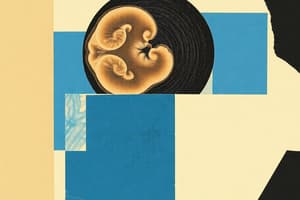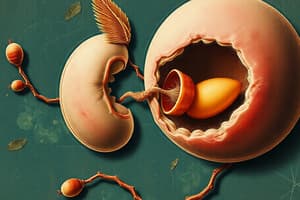Podcast
Questions and Answers
Gametogenesis is the process of formation and development of highly specialized sex cells called gametes or ______ cells
Gametogenesis is the process of formation and development of highly specialized sex cells called gametes or ______ cells
germs
Elsewhere in the body of the embryo, undifferentiated primordial germ cells (PGCs) migrate into the gonads where they begin to differentiate depending on the sex of the organism: spermatogonia for males, ______ for females
Elsewhere in the body of the embryo, undifferentiated primordial germ cells (PGCs) migrate into the gonads where they begin to differentiate depending on the sex of the organism: spermatogonia for males, ______ for females
oogonia
Four processes occur during gametogenesis: mitosis, growth, ______, and differentiation
Four processes occur during gametogenesis: mitosis, growth, ______, and differentiation
meiosis
Meiotic divisions reduce the chromosome number in half and allow for ______
Meiotic divisions reduce the chromosome number in half and allow for ______
Gametogenic cells undergo mitotic divisions to increase their ______
Gametogenic cells undergo mitotic divisions to increase their ______
Differentiation makes the germ cells specialized to carry out their specific ______
Differentiation makes the germ cells specialized to carry out their specific ______
Spermatogenesis refers to the entire sequence of events by which the primitive germ cells, the diploid spermatogonia, give rise to haploid spermatozoa or ______ cells.
Spermatogenesis refers to the entire sequence of events by which the primitive germ cells, the diploid spermatogonia, give rise to haploid spermatozoa or ______ cells.
This process occurs in the seminiferous tubules inside the ______.
This process occurs in the seminiferous tubules inside the ______.
Each tubule is lined with a germinal epithelium that is made up of two types of cells: the developing spermatogenic cells in various stages of development, and the Sertoli (sustentacular) cells that support the development of the ______ cells.
Each tubule is lined with a germinal epithelium that is made up of two types of cells: the developing spermatogenic cells in various stages of development, and the Sertoli (sustentacular) cells that support the development of the ______ cells.
Leydig cells located outside of the Seminiferous tubules are responsible for secreting the hormone testosterone for ______.
Leydig cells located outside of the Seminiferous tubules are responsible for secreting the hormone testosterone for ______.
Once the migrating primordial germ cells (PGCs) have reached the developing gonad (future testis), they differentiate into the first type of spermatogenic cells, the ______.
Once the migrating primordial germ cells (PGCs) have reached the developing gonad (future testis), they differentiate into the first type of spermatogenic cells, the ______.
The spermatogonia remain dormant until conditions are favorable for ______.
The spermatogonia remain dormant until conditions are favorable for ______.
In humans, spermatogenesis begins at ______.
In humans, spermatogenesis begins at ______.
The diploid spermatogonia that differentiated from the PGCs are located close to the basement membrane of the seminiferous tubule. These cells undergo mitotic divisions and give rise to two types of ______.
The diploid spermatogonia that differentiated from the PGCs are located close to the basement membrane of the seminiferous tubule. These cells undergo mitotic divisions and give rise to two types of ______.
Spermatogonium A remains close to the basement membrane of the seminiferous tubule. It retains its mitotic function, thus responsible for the continuous supply of ______ cells throughout the life of the organism.
Spermatogonium A remains close to the basement membrane of the seminiferous tubule. It retains its mitotic function, thus responsible for the continuous supply of ______ cells throughout the life of the organism.
Spermatogonium B is displaced farther from the basement membrane of the seminiferous tubule towards the lumen. It does not retain its mitotic function but enters the next phase of ______.
Spermatogonium B is displaced farther from the basement membrane of the seminiferous tubule towards the lumen. It does not retain its mitotic function but enters the next phase of ______.
Flashcards are hidden until you start studying




